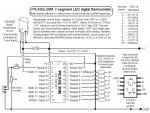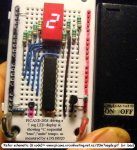The quote below...
...prompts this idea.
My guess is that many of those who ask for help are new to the platform.
Posting files to a web site is a familiar practice for the technically minded. But in thinking through a tutorial for this problem I (believe so at least) found a key roadblock.
It is in first thinking of the best/fastest means to draw and capture the circuit that can bog you down.
Do you:
-Use "Paint"? Editing becomes cumbersome after a few lines.
-Surf for a quick drawing app? 10 mins of searching, still too long. "I could have drawn the circuit by now".
-Hand draw, and photograph. What if you don't have a card reader or the camera's transfer cable handy? Cellphone snaps...are often poor with detail.
If under deadline, I would have given up and just written.
Idea: Make it easy.
Reply to all circuit questions with:
Questions submitted with supporting diagrams receive priority attention.
Create your drawing "here". http://www.rev-ed.co.uk/picaxe/pebble/
How many people who hit this board cold, know this online tool exists?
Perhaps a special "fixed" breadboard version that can be automatically linked to a post? Or simply a drop down with steps including Alt-PrtScn for resized window capture, then dump to Paint.
In sales the mantra is "Make it easy for them to buy".
Perhaps this would help?
Terry
http://www.picaxeforum.co.uk/showthread.php?t=16734Get out of bed and give us a drawing. Spend 10 minutes on a lovely sketch. Otherwise you'll get 50 replies (possibly based on ambiguous information) and you'll only read the last three.
...prompts this idea.
My guess is that many of those who ask for help are new to the platform.
Posting files to a web site is a familiar practice for the technically minded. But in thinking through a tutorial for this problem I (believe so at least) found a key roadblock.
It is in first thinking of the best/fastest means to draw and capture the circuit that can bog you down.
Do you:
-Use "Paint"? Editing becomes cumbersome after a few lines.
-Surf for a quick drawing app? 10 mins of searching, still too long. "I could have drawn the circuit by now".
-Hand draw, and photograph. What if you don't have a card reader or the camera's transfer cable handy? Cellphone snaps...are often poor with detail.
If under deadline, I would have given up and just written.
Idea: Make it easy.
Reply to all circuit questions with:
Questions submitted with supporting diagrams receive priority attention.
Create your drawing "here". http://www.rev-ed.co.uk/picaxe/pebble/
How many people who hit this board cold, know this online tool exists?
Perhaps a special "fixed" breadboard version that can be automatically linked to a post? Or simply a drop down with steps including Alt-PrtScn for resized window capture, then dump to Paint.
In sales the mantra is "Make it easy for them to buy".
Perhaps this would help?
Terry








